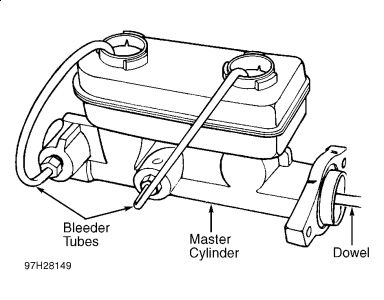https://youtu.be/w7gUsj2us0U
and
https://youtu.be/WDxvEQrMkBg
and
https://www.2carpros.com/articles/brake-pedal-goes-to-the-floor
Please run down these guides and report back.
Bleed wheel cylinders and calipers in sequence. See BLEEDING SEQUENCE table.

Master Cylinder (Bench Bleeding) 1. Bench bleed master cylinder before installation. Place master cylinder in soft-jaw vise. Install bleeder tubes in both outlets of master cylinder. See Fig. 1 . 2. Fill master cylinder with clean brake fluid. Ensure ends of bleeder tubes are submerged in brake fluid. 3. Using a wood dowel, apply and release master cylinder until no air bubbles exist in brake fluid flow. Leave bleeder tubes installed on master cylinder during installation. Install master cylinder. Remove bleeder tubes, and connect brakelines. Bleed brake system if necessary.

Vacuum Bleeding Fill master cylinder. Install vacuum bleed equipment to first bleeder valve to be serviced. Open bleeder valve 3/4-1 turn. Depress vacuum pump, and pull fluid into reservoir jar. Bleed each bleeder valve in sequence. See BLEEDING SEQUENCE table. Pressure Bleeding 1. Clean master cylinder cap and surrounding area. Remove cap. With pressure tank at least 1/2 full, connect it to master cylinder using appropriate adapters. Attach bleeder hose to first bleeder valve to be serviced. See BLEEDING SEQUENCE table. 2. Submerge other end of hose in clean glass jar partially filled with clean brake fluid. Position metering valve properly before pressure bleeding. 3. Open release valve on pressure bleeder. Follow equipment manufacturer's pressure bleeding
CAUTION: When using pressure bleeding method, press and hold in valve stem on combination valve to properly bleed brake system.
Was this helpful?
Yes
No
Saturday, February 27th, 2021 AT 11:16 AM
(Merged)



